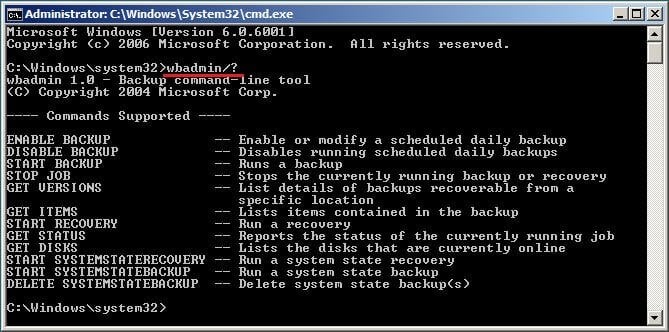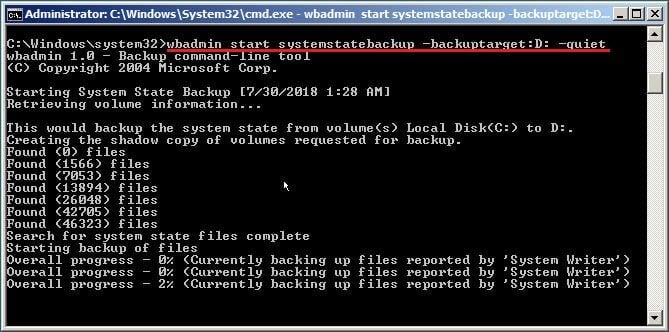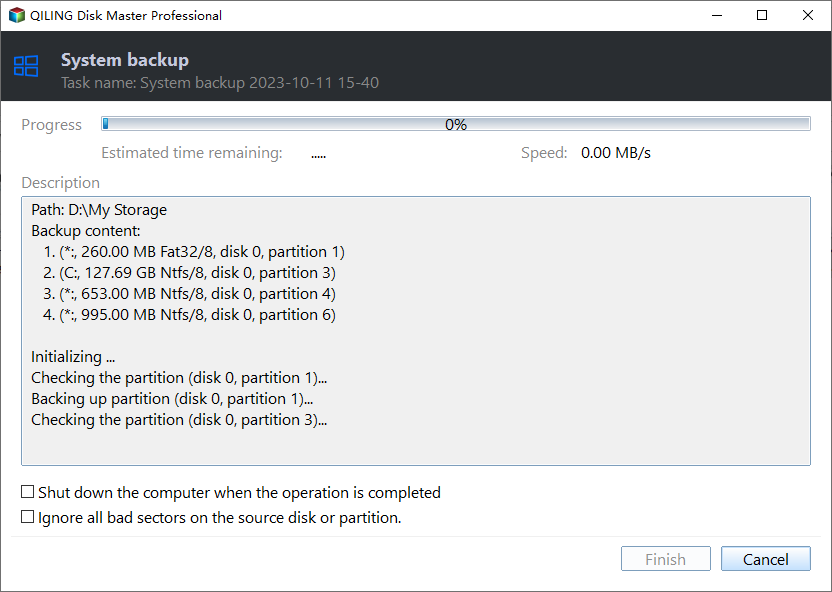Use WBAdmin Start Systemstatebackup Command for System Protection
What can Wbadmin do for you?
Wbaddmin (Wbaddmin.exe) is as a part of Windows Backup and Restore (previously known as Windows Backup), which displaces the NTBackup (the previous built-in backup application for Windows 2000, Windows XP, Windows Server 2003). Wbadmin is a backup command-line utility built-into Windows Vista, Windows 7, Windows 8, Windows 10, Windows Server 2008 (R2), and Windows Server 2012.
Wbadmin allows you to backup and restore your Windows operating system, volumes, files, folders, and applications from a command prompt or its interface. You could use the simple way to access WBAdmin backup command line utility:
- Click Start and type cmd and hit enter.
- Right-click Command Prompt and choose Run as Administrator.
- Then run Wbaddmin commands to backup.
In order to show all the supported backup and restore commands of Wbadmin in your Windows version, input this command: wbadmin/? .
★ Important: To perform all the backup tasks, you must be a member of the Backup Operators or the Administrators group, or you must have the appropriate permissions.
How to use Wbaddmin start systemstatebackup command
According to Microsoft, the Wbadmin start systemstatebackup command applies to Windows Server 2008 and later OS, such as Windows Server 2008 R2, Windows Server 2012, etc.
The system state backup here includes all the operating configuration files that can be used for a disaster recovery on the same server or another server with similar hardware, that is, boot files, active directory, sysvol, certificate services, cluster database, the registry, performance counter configuration information, and component Services Class registration database.
To backup Windows Server 2008 (R2) system, for example, you could enter the below syntax of Wbadmin system state backup command to realize:
wbadmin start systemstatebackup –backuptarget:{volumename} [-quiet]
★ Notes:
1. {} are the required parameters; [] are the optional parameters.
2. The volumename requires a drive letter, a GUID-based volume name, or network share.
3. Quiet means execute the backup without prompts.
Here is the WBAdmin start systemstatebackup example:
Wbadmin start systemstatebackup –backuptarget: D: -quiet
✍ Tip on how to use Wbadmin start sysrecovery command:
After using Wbadmin start systemstatebackup command to get a backup copy for your Windows Server 2008 or 2008 R2 system. Then you might need to do Windows Server 2008 (R2) system state recovery in the future, the syntax listed below just in case:
wbadmin start sysrecovery -version:-backupTarget:{|}[-machine:][-restoreAllVolumes] [-recreateDisks] [-excludeDisks] [-skipBadClusterCheck] [-quiet]
For example, to start recovering the information from the backup that was run on Jun, 1, 2016 at 06:48 A.M., located on drive E: for WIN-9814GD4FH95:
Wbadmin start sysrecovery –version: 6/1/2016-06:48 –backuptarget:E: -machine:WIN-9814GD4FH95
★ Important: TIf you don’t know the version Identifier, you could use wbadmin get versions.
How to use Wbadmin Proceed for bare metal backup
Besides Wbadmin start systemstatebackup command, it still provides Wbadmin Proceed bare metal to help you create a bare metal backup in Windows 7/8/10, or in Windows Server 2008, Server 2012. The syntx of it are below:
wbadmin Proceed –backuptarget:{/} –allcritical [–systemstate] -quiet
★ Important:
1. The target volume for a critical-volume backup can be a local drive, but it cannot be any of the volumes that are included in the backup.
2. If you save a backup to a remote shared folder, that backup will be overwritten if you use the same folder to back up the same computer again. In addition, if the backup operation fails, you may end up with no backup because the older backup will be overwritten, but the newer backup will not be usable.
WBAdmin Proceed example:
wbadmin Proceed –backuptarget:H: –allcritical –systemstate -quiet
✍Tip on how to use Wbadmin start recovery command:
Similar to Wbadmin start systemstatebackup command, you may want to restore the created backup image one day. Below are the syntax for Wbadmin start recovery:
wbadmin start recovery -version: -items:{ | | } -itemtype:{Volume | App | File} [-backupTarget:{ | }] [-machine:] [-recoveryTarget:{ | }] [-recursive] [-overwrite:{Overwrite | CreateCopy | Skip}] [-notRestoreAcl] [-skipBadClusterCheck] [-noRollForward] [-quiet]
★ Important:
1. The items parameter refers to the volumes, apps, files, or folders you want to recover. And you need to use it together with the -itemtype parameter.
2. The recovery taget requires if you want to restore backup image to other location instead of its original location.
Wbadmin start recovery example:
wbadmin start recovery -version:03/31/2020-09:00 -itemType:App -items:Registry -recoverytarget:d:\
Easier way to create a system backup to protect data on it
Although Wbadmin provides you with multiple choices to protect system, but you may find it's quite complex for general users who was not familiar with Wbadmin or command line. Before using it, you need to learn all the parameters you will use and it's easy to make mistakes. Besides, not all computers support all the WBAdmin’s functions.
Thus, many users may want an easier way to protect their system and data on it. As a matter of fact, you can use various backup software with a graphic user interface as Wbadmin alternative, Qiling Disk Master Server is one of the excellent options. It supports creating system image to include data on the system partition. Also, you can choose to backup entire disk with everything on it. And you can enjoy some obvious advantages of it:
- Backup system or disk automatically: It supports 5 schedule backup options, you can choose daily, weekly or monthly as backup frequency, or use Event trigger and USB plug in for backup.
- Save disk space: It provides you with multiple settings to reduce backup size, such as, Normal or High compression level, Intelligent Sector Backup, Incremental or Differential Backup, Backup Scheme, etc. Among them, the most efficient way is to delete old backup images with Backup Scheme.
- Support all the Windows systems: The supported OS includes Windows 10, 8.1, 8, 7 and Server 2003, 2008(R2), 2012(R2), 2016, 2019.
Furthermore, it provides you either command line or graphic users interface (GUI) to backup data, and supports you restore system in Windows environment or without Windows (Qiling Disk Master Recovery Environment).
Here are the steps to create system backup via Qiling Disk Master Server:
1. Please download the best system state backup software - Qiling Disk Master Server 30-day free trial. Install and execute it.
2. Click Backup -> System Backup on the main window.
3. Enter a task name and choose a destination to save your system state backup image.
★ Tip: The program will select the system partitions accociated with system files automatically, you don’t have to select manually.
4. Press the Proceed button to create system state backup for Windows PCs and Servers.
★ Tips:
✍ You could enable Schedule option to backup your system daily/weekly/monthly/event trigger/USB plug in; You could set comment, compress, encryptor split system state backup, etc.
✍ Backup Scheme allows you to delete old backup images automatically when meet the retention policy to manage disk space. Also, you can set incremental or differential backup to backup only changed files, which greatly save disk space.
Qiling Disk Master is quick-acting for Windows backup and restore that you could rely on.
Summary
You can easily create system backup with Wbadmin start systemstatebackup command or Wbadmin Proceed command if you are a professional. If not, you may feel it's difficult and error-prone. In this case, Qiling Disk Master Server will be the best choice.
With it, you can create a system image backup for Windows PCs and Servers in simple steps, no technical requirement and easy to operate. And you can schedule backup system and always keep enough space for new backup with its useful features. More surprising, it's a command line utility(DiskMasterUI.exe). Thus, it can be used by both home users and professionals.
If you would like to protect unlimited computers or servers, please try Qiling Disk Master Technician Plus. And it allows you to Create bootable media of this software and take it everywhere.
Related Articles
- Create Files and Folders Backup with Wbadmin Command Line
- How to Use Wbadmin Proceed Backuptarget
- How to Perform System State Recovery with Wbadmin
- Windows 10 Upgrade Keeps Restarting (Fixed with 3 Ways)
Windows 10 keeps restarting? This guide will tell you 5 methods to fix the Windows 10 update keeps restarting issue.





